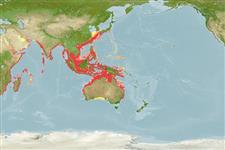| Native range |

|
| Netuma thalassina AquaMaps Data sources: GBIF OBIS |
Length at first maturity
Lm 36.0, range 33 - 45 cm
Human uses
Fisheries: commercial; gamefish: yes
Phylogenetic diversity index
(Ref. 82805)
PD50 = 0.6250 many relatives (e.g. carps) 0.5 - 2.0 few relatives (e.g. lungfishes)
Trophic Level
(Ref. 69278)
3.5 ±0.2 se; Based on diet studies.
Resilience
(Ref. 69278)
Low, minimum population doubling time 4.5 - 14 years (K=0.06-0.45; tm=2-4; tmax=19)